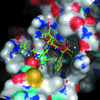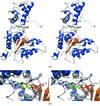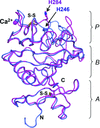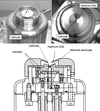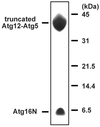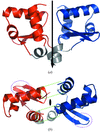issue contents
May 2008 issue
2nd International Symposium on Diffraction Structural Biology (ISDSB2007)
Tower Hall Funabori, Tokyo, Japan, 10-13 September 2007

Cover illustration: The reaction centre for disulfide bond generation in E. coli, which is composed of DsbB (emerald ribbon) and ubiquinone (purple stick) (see Inaba, pages 199-201). The disulfide bond generated here (shown with yellow mesh) is transferred to downstream proteins oxidatively folding via DsbA, a primary disulfide-donating enzyme. (Figure produced by Kenji Inaba and Mamoru Suzuki.)
facility information
diffraction structural biology
Open  access
access
 access
accessThe crystal structure of the DsbB–DsbA–ubiquinone ternary complex has revealed a mechanism of protein disulfide bond generation in Escherichia coli.
Open  access
access
 access
accessUltrahigh-resolution protein diffraction data allow valence electron density modelling and calculations of experimental electrostatic properties. Protein–ligand interaction energy may therefore be estimated.
Open  access
access
 access
accessCrystal structures of protease/inhibitor complexes guided optimization of the buried nonpolar surface area thereby maximizing hydrophobic binding. The resulting potent tripeptide inhibitor is in clinical trials.
Open  access
access
 access
accessThe crystal structures of the Helicobacter pylori FtsH ATPase domain in the nucleotide-free state and complexed with ADP have been determined.
Open  access
access
 access
accessSingle-particle analysis is a computer-aided method for determining protein structure using projection images obtained by electron microscopy. Recently reconstructed 6-TM-type cation channels demonstrate the structural similarities and divergence of the family.
Open  access
access
 access
accessThe capabilities of the Protein Crystallography Station at Los Alamos Neutron Science Center for determining protein structures by spallation neutron crystallography are illustrated, and the methodological and technological advances that are emerging from the Macromolecular Neutron Crystallography consortium are described.
Open  access
access
 access
accessConformational changes of RseA and RseB were observed by circular dichroism and small-angle X-ray scattering upon the formation of their complex.
Open  access
access
 access
accessMany supramolecular complexes form crystals that have lattice constants of the order of 1000 Å. An optimized method for data collection and processing is described.
Open  access
access
 access
accessFragment-based methods are successfully generating novel and selective drug-like inhibitors of protein targets, with a number of groups reporting compounds entering clinical trials. This paper summarizes the key features of the approach as one of the tools in structure-guided drug discovery.
Open  access
access
 access
accessA very compact X-ray generator, 4.3 times more brilliant than can be attained by a conventional rotating-anticathode X-ray generator, has been developed using a U-shaped rotating anticathode and a high-flux electron gun with focusing bending magnet.
Open  access
access
 access
accessIn situ microzone X-ray diffraction analysis of natural teeth is presented. From our experiment, layer orientation and continuous crystal variations in teeth could be conveniently studied using fast online measurements by high-resolution X-ray microdiffraction equipment.
Open  access
access
 access
accessMolecular dynamics and the ab initio fragment molecular orbital method were applied to investigate the interaction of HIV-1 aspartic protease with its inhibitor. The interaction energy of the inhibitor at the active sites of aspartic acid obtained by the ab initio fragment molecular orbital method was as great as 50 kcal mol−1, coinciding with a tetrahedral transition state.
Open  access
access
 access
accessThe crystal structure and ligand-binding study of M-ficolin provides an insight into its discrimination mechanism between self and non-self.
Open  access
access
 access
accessSubstrates tagged with ssrA are recognized and degraded by a subset of the Clp family, ATP-dependent proteases in prokaryotes. This paper describes the mechanism of intracellular breakdown of ssrA-tagged substrates by ClpXP and its adaptor protein, SspB.
Open  access
access
 access
accessThe catalytic mechanism of D-amino acid amidase from Ochrobactrum anthropi SV3 has been deduced.
Open  access
access
 access
accessThe crystal structure of the K138A mutant of the 1510-N protease specific for p-stomatin was determined at 2.3 Å resolution. The structure shows a novel dimer form, and the kinked L2 loop indicates that Lys138 would probably have an important effect on the conformation of L2.
PDB reference: 3bpp
Open  access
access
 access
accessThe development of an electron gun for a high-brightness X-ray generator whose target brilliance is 60 kW mm−2 is reported.
Open  access
access
 access
accessTwinned crystals of humaan MD-2 are transformed into single crystals with cryoprotectant optimization.
Open  access
access
 access
accessThe Atg12–Atg5 conjugate was prepared by in vivo reconstitution and was crystallized with Atg16 using the free-interface diffusion method.
Open  access
access
 access
accessTo investigate quantitatively the effects of stirring on protein crystallization, a new stirring system which can agitate a protein solution, ∼100 nl, by providing Hagen–Poiseuille flow has been successfully developed.
Open  access
access
 access
accessThe structure of mouse Keap1-DC complexed with the DLG motif peptide of Nrf2 transcription factor was determined at 1.9 Å resolution. The structure showed that the peptide binds to Keap1-DC at the bottom region of the β-propeller domain.
Open  access
access
 access
accessHydrogen bonds of DNA-binding protein DsrD have been determined by neutron diffraction. In terms of proton donors and acceptors, DsrD protein shows striking differences from other proteins.
Open  access
access
 access
accessA new detector system for protein crystallography based on an X-ray HARP–FEA is presented.
Open  access
access
 access
accessSeveral mutations at Glu81 located on the crystal contact of human acidic fibroblast growth factor were studied in an effort to improve crystal growth. Mutation to Ser and Thr resulted in crystallization of a rather bulky form of the wild type, whereas mutation to Val prohibited crystallization. These results suggest that crystal growth may be controlled by designing a new interface by protein engineering.
Open  access
access
 access
accessA mail-in data collection system at SPring-8, which is a web application with automated beamline operation, has been developed.
Open  access
access
 access
accessBL-17A is a new structural biology beamline at the Photon Factory, dedicated to protein crystallography of microcrystals. Here the X-ray beam stabilization techniques used at BL-17A are described.
Open  access
access
 access
accessAt the Photon Factory macromolecular crystallography beamlines, two new functions, remote monitoring and diffraction image evaluation, have been developed and installed on the beamline controlling system STARS (simple transmission and retrieval system).
Open  access
access
 access
accessSample-exchange robots with a double-tongs system that could exchange samples within 10 s have been developed.
Open  access
access
 access
accessThe characterization of a PsbTc-truncated mutant photosystem II complex is described.
Open  access
access
 access
accessThe 1/2SLPI and HNE complex structure was solved at 1.7 Å resolution and compared with the interaction mechanism of elafin.
Open  access
access
 access
accessHen egg-white lysozyme was crystallized over a wide pH range (2.5–8.0) and the quality of the crystals was characterized. Crystallization phase diagrams at pH 2.5, 6.0 and 7.5 were determined
Open  access
access
 access
accessEffect of amino acids and amino acid derivatives on crystallization of hemoglobin and ribonuclease A
The effect of the addition of amino acids and amino acid derivatives on the crystallization of hemoglobin and ribonuclease A has been evaluated. The results showed that certain types of additives expand the concentration conditions in which crystals are formed.
current events
Free 



 journal menu
journal menu

















